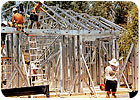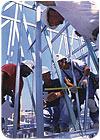
Builders are learning to build better with steel studs as the Steel Framing Alliance provides education and training as well as technical and code support. The switch to steel is for numerous reasons, such as uniform product quality and lighter weight for easier handling and framing. Owners and builders also see steel as durable for longer life and better security.
These and other practical considerations typically drive the business decision to make the switch to steel. However, builders should learn more about steel’s superior environmental benefits. For starters, North American steel has always had an average minimum 25 percent recycled content. Those needing authoritative post-consumer and pre-consumer statistics for USGBC LEED-NC v2.2, may download “Steel Takes LEED With Recycled Content” at www.recycle-steel.org.
Not only does steel have recycled content when new, it is also 100 percent recyclable at the end of life. In the United States, about 76 million tons of steel are collected, processed, and ultimately recycled into new products annually, from cars to cans to appliances and, of course, new construction materials, including steel studs and cool metal roofing. Recycling saves energy and other natural resources as embodied energy is amortized over future generations of new steel.

Steel studs are straight and true, as well as dimensionally stable, thus helping to create a tighter building envelope that does not age in appearance or function. Good insulation design and construction easily overcome thermal conductance. The energy for lighting, heating, and cooling a building over its long service life is many times larger than the embodied energy of the building materials. Steel stud framing, which does not age or deflect around doors, windows, and other openings, can reduce unwanted air infiltration and thus save significant energy.
The high strength to weight ratio of steel allows members to be lighter weight, from standard steel stud “C”-sections to specialized joists, trusses, and panels. This results in easier handling and framing. Benefits go further, however, since transportation expense and fuel consumption are reduced as steel studs are manufactured locally or even made into needed shapes right on the job site.
In January 2000, Scientific Certification Systems, Inc. published a report called, “Analysis of Galvanized Steel Production Suitable for Residential Construction Based on Life-Cycle Stressor-Effects Assessment: A U.S. Case Study.” Among its conclusions is the finding that, for building an equal number of homes, the permanent ecosystem disruption for steel stud production is less than 1 percent of the permanent ecosystem disruption for equivalent wood stud production, even assuming harvest cycles of 70 years and no clear-cutting.
Both practical and “green”, steel studs are indeed a natural for the environment with so many tangible energy and resources savings benefits. Owners and builders can learn more about steel framing at www.steelframing.org.

Report Abusive Comment